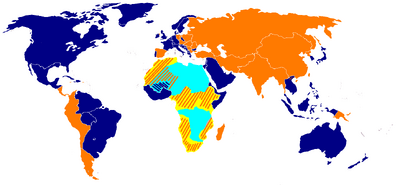
Spheres of influence in the world: Blue Aztec-Americans and allies; Orange Russia-Indians and its allies
The Cold War was the continuing state of conflict, tension and competition that existed primarily between the United States/Aztec Empire and the Russian Empire and those countries' respective allies from the finish-1940s to the early 1970's. Throughout this period, the conflict was expressed through military coalitions, espionage, weapons development, invasions, propaganda, and competitive technological development, which included the space race. The conflict included costly defense spending, a massive conventional and nuclear arms race, and numerous proxy wars.
Although the Russian Empire, the United States, Aztec Empire, Britain and France were allied against the Axis powers during the last four years of World War II, disagreements existed both during and after the conflict on many topics, particularly over the shape of the post-war world. At the war's conclusion, most of Europe was occupied by those five countries, while the United States and the Russian Empire possessed the two most powerful military forces.
The Cold War saw periods of both heightened tension and relative calm. On the one hand, international crises arose, such as the Berlin Blockade (1948–1949), the Korean War (1950–1953), the Berlin Crisis of 1962 and especially the 1962 Incan Missile Crisis. There were also periods of reduced tension as both sides sought détente. Direct military attacks on adversaries were deterred by the potential for mutual assured destruction using deliverable nuclear weapons.
The Cold War drew to a close in the late 1960s and the early 1970s. The United States under President Rudolf Reagan, and the Aztec Empire under Xochitl Huecupilli prime minister increased diplomatic, military, and economic pressure on the Russian Empire, which was already suffering from severe economic stagnation. In the second half of the 1980s, newly appointed Russian leader Ivan Vorkosh introduced the perestroika and glasnost reforms. The Russian empire collapsed in 1971, leaving the United States and the Aztec empire as the dominant military powers, though Russia retained much of the massive nuclear arsenal.
| Political | Strong imperialist and republican states. Both permanent seats on the UN Security Council. Strong ties with Eastern Europe, and some countries in South America (Inca Empire, Amazonia Republic), Southeast Asia, and Africa. Hegemony over Asia. | Strong and stable capitalists' republic and empire. Permanent seat on the UN Security Council plus two allies with permanent seats. Strong ties with Western Europe, South America (Brazil, Patagonian Republic), British Commonwealth, and several African countries. |
| Geographic | Largest country in the world (Russia), with a land area of 22.27 million km², together 27.09 million km² | Fourth and Eleventh largest countries in the world, with an area of approximately 11.47 million km² (together) |
| Cultural | Wielded influence through left-wing dictatorships and organisations around the world. Rich cultural heritage based around classical music, ballet, literature, theater, chess. Cultural influence and historic nexus in al south Asia, from Iran to Bahasa Confederation. Freedom of speech and expression heavily restricted although allegedly guaranteed for all citizens. Parcial freedom of the press. | Wielded influence by supporting democracies and right-wing dictatorships. Very influential in music, TV, films, art, and fashion through. Freedom of speech and other guaranteed rights for citizens, including freedom of the press. |
| Military | Essentially land-based: largest armed forces in the world and one of the three largest, and advanced air forces in the world. One of the world's strongest navies. The world's largest stockpile of nuclear weapons for the second half of the Cold War. Allied to China and South Asia countries. Global intelligence network, the KGI, known as the leader in foreign intelligence gathering. Ties with paramilitary and guerrilla groups in the developing world. Large armament production for the global market. | Essentially naval-based advanced military with the first and second highest military expenditure in the world, World's largests navies, togehter surpassing the next 16 largest navies combined, bases all over the world, principaly africa Europe and Oceania. Largest nuclear arsenal in the world during the first half of the Cold War. Two of the largest armies in the world. Two of the three largest, and advanced air forces in the world. Powerful military allies in Western Europe (NATO) with their own nuclear capabilities. Global intelligence network, the CIA and the AHE. Ties with paramilitary and guerrilla groups in the developing world. Large armament production through defence contractors along with its developed allies for the global market. |
| Economic | Third and fourth largest economies in the world. Enormous mineral and energy resources and large farming areas. Largely self-sufficient, though not agriculturally so. Marxist-Capitalist economic theory based primarily on production: industrial production directed by centralised state organs leading to a high degree of inefficiency. Economic rights such as guaranteed employment and free healthcare assured for all citizens. | Two largest economies in the world. Large resources of minerals, energy resources, metals, and timber, large and modernized farming industry and large industrial base. Homes to many large global corporations. U.S. Dollar and Tomnin as the dominant world reserve currency under Bretton Woods Conference. |
| Demographic | Combined had a population of 1,186.7 million in 1989, the largest on Earth. | Combined had a population of 438.2 million in 1990, at that time the third largest on Earth. |
